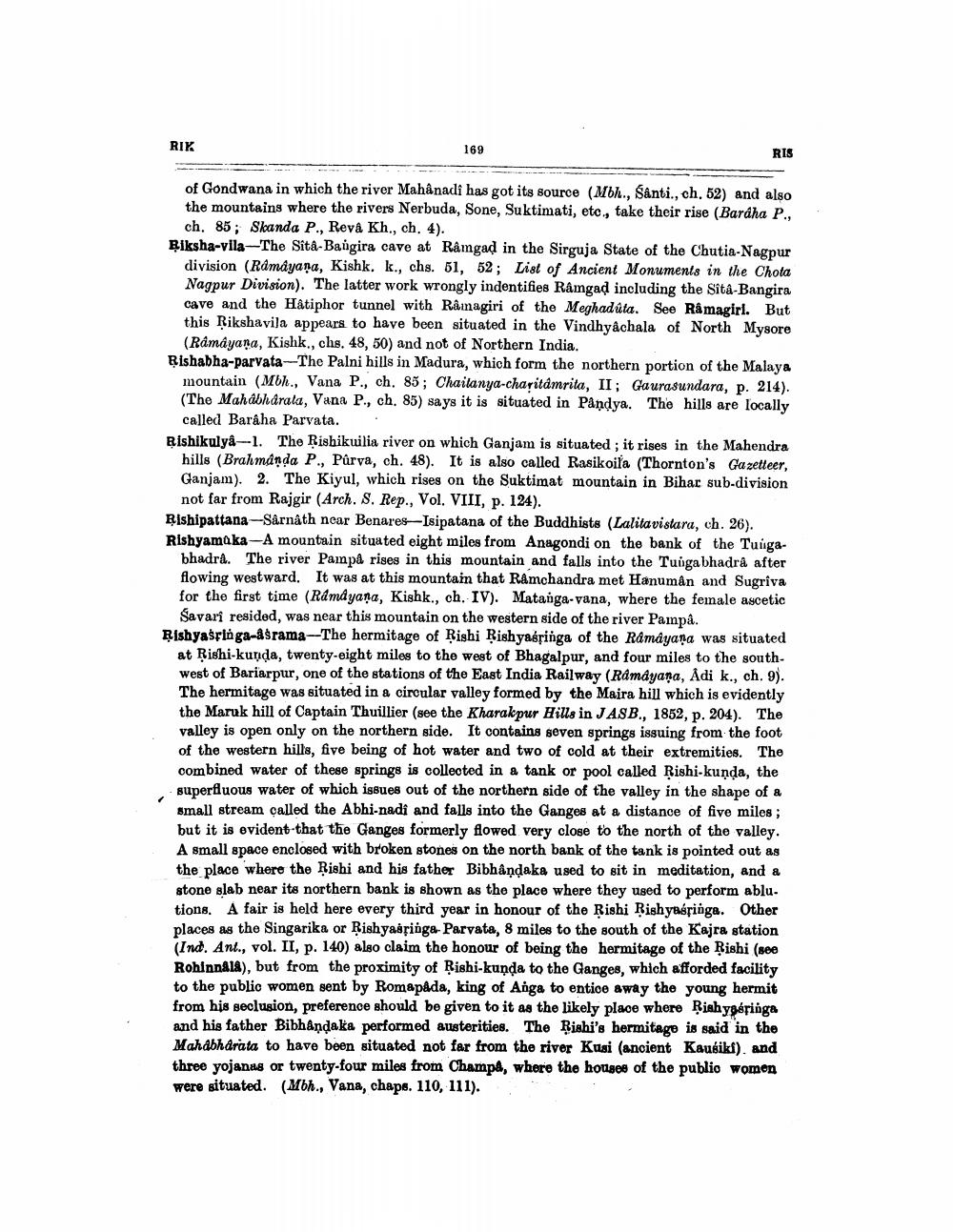________________
RIK
169
RIS
of Gondwana in which the river Mahanadi has got its source (Mbh., Śânti., ch, 52) and also the mountains where the rivers Nerbuda, Sone, Suktimati, etc., take their rise (Baráha P.,
ch. 85; Skanda P., Reva Kh., ch. 4). Biksha-vila-The Sita-Bangira cave at Ramgad in the Sirguja State of the Chutia-Nagpur
division (Ramayana, Kishk, k., chs. 51, 52; List of Ancient Monuments in the Chota Nagpur Division). The latter work wrongly indentifies Ramgad including the Sita-Bangira cave and the Hatiphor tunnel with Rainagiri of the Meghadata. See Råmagirl. But this Rikshavila appears to have been situated in the Vindhyâchala of North Mysore
(Ramayana, Kishk., chs. 48, 50) and not of Northern India. Rishabha-parvata-The Palni hills in Madura, which form the northern portion of the Malaya
mountain (Mbh., Vana P., ch, 85; Chaitanya-charitamrita, II; Gaurasundara, p. 214). (The Mahabharata, Vana P., ch. 85) says it is situated in Pandya. The hills are locally
called Barkha Parvata. Rishikulya-1. The Rishikuilia river on which Ganjam is situated; it rises in the Mahendra
hills (Brahmanda P., Parva, ch. 48). It is also called Rasikoila (Thornton's Gazetteer, Ganjam). 2. The Kiyul, which rises on the Suktimat mountain in Bihac sub-division
not far from Rajgir (Arch. S. Rep., Vol. VIII, p. 124). Rishipattana--Sarnath near Benares Isipatana of the Buddhists (Lalitavistaru, ch. 26). Rishyamaka-A mountain situated eight miles from Anagondi on the bank of the Tuiga
bhadra. The river Pampå rises in this mountain and falls into the Tuugabhadra after flowing westward. It was at this mountain that Ramchandra met Hanuman and Sugriva for the first time (Ramdyana, Kishk., ch. IV). Matanga-vana, where the female ascetic
Savari resided, was near this mountain on the western side of the river Pampa. Rishyasrlóga-Asrama --The hermitage of Rishi Rishyasringa of the Ramayana was situated
at Rishi-kunda, twenty-eight miles to the west of Bhagalpur, and four miles to the southwest of Bariarpur, one of the stations of the East India Railway (Ramayana, Adi k., ch. 9). The hermitage was situated in a circular valley formed by the Maira hill which is evidently the Maruk hill of Captain Thuillier (see the Kharakpur Hills in JASB., 1852, p. 204). The valley is open only on the northern side. It contains seven springs issuing from the foot of the western hills, five being of hot water and two of cold at their extremities. The combined water of these springs is collected in a tank or pool called Rishi-kunda, the superfluous water of which issues out of the northern side of the valley in the shape of a small stream called the Abhi-nadî and falls into the Ganges at a distance of five miles ; but it is evident that the Ganges formerly flowed very close to the north of the valley. A small space enclosed with broken stones on the north bank of the tank is pointed out as the place where the Rishi and his father Bibhâņdaka used to sit in meditation, and a stone slab near its northern bank is shown as the place where they used to perform ablu. tions. A fair is held here every third year in honour of the Rishi Rishyasringa. Other places as the Singarika or Rishyaafinga Parvata, 8 miles to the south of the Kajra station (Ind. Ant., vol. II, p. 140) also claim the honour of being the hermitage of the Rishi (see Rohinnala), but from the proximity of Rishi-kunda to the Ganges, which afforded facility to the public women sent by Romapada, king of Anga to entice away the young hermit from his seclusion, preference should be given to it as the likely place where Rishygépinga and his father Bibhåndaka performed austerities. The Rishi's hermitage is said in the Mahabharata to have been situated not far from the river Kusi (ancient Kausikl). and three yojanas or twenty-four miles from Champa, where the hongee of the public women were situated. (Mbh., Vana, chaps. 110, 111).




